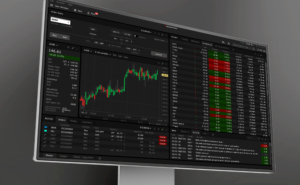TSM announced better-than-expected quarterly results and lifted its growth projections for this year’s revenue. Good news helped limiting the previous day selloff in chip stocks yesterday but couldn’t prevent the S&P500 and Nasdaq 100 from closing Thursday’s session with losses. The S&P500 fell 0.78% and Nasdaq 100 lost almost 0.50%. Nvidia rebounded more than 2.50% after the strong TSM results revived the AI optimism despite the growing worries of worsening chip war between the US and China. But TSM shares fell 2% in the Taiwan Stock Exchange today. Besides the sharp selloff triggered by Biden’s threat on China chip exports, the euphoria around the AI stocks diminished as Goldman Sachs warned that the biggest US tech firms may be spending too much on AI without a guarantee of seeing their investment bear fruit in a sufficiently satisfactory timeline. The rising odds of a Trump presidency is not necessarily positive for TSM, either, as he looked barely willing to defend Taiwan in case of a Chinese aggression. Moreover, a Trump and Vance duo in the White House is good for technology stocks – but the small one of them, and should not necessarily benefit to the Big Tech.
Unbearable
Biden is under an unbearable pressure to leave the presidential race because he is too old. Many Democratic heavy weights are now turning their back against the President. Even Barrack Obama said he should consider stepping down. And there are rumours that he could throw in the towel as early as this weekend. If that happens, we could see the Trump trade gain further momentum. That would benefit to Bitcoin, equities – especially the small and domestically focused ones – and cause a yield curve steepening with the long-end of the US treasuries feeling the heat of exploding debt
Some ask how long this Trump trade will last. The answer is a few weeks, maybe a few months, time to give the non-tech pockets of the market to catch their breath and the tech to correct following a breathtaking year-and-a-half rally. But in fine, factors like the Federal Reserve (Fed) and other central banks’ policy decisions, the international trade tensions, the global growth prospects, China, climate and idiosyncratic factors like AI should say the last word on the overall direction of the global stock markets.
Global picture
For now, the reflation trade favours the cyclical sectors (oil and finance) and small caps in the US, and a shift toward the European equities. Alas, European stocks kicked off the earnings season on a meagre note with weak results from luxury and airline sectors. It’s early to predict where the earnings season will go for the European companies. The European Central Bank’s (ECB) first rate cut should have lifted sentiment for many companies in Q2, but analysts have been revising down their earnings expectations since a few weeks.
Moving forward, the ECB is not confident that September will bring the second rate cut, and they don’t want the market to think that there will be a 25bp rate cut to be pulled out from their hat at the end of the summer. The ECB Chief Christine Lagarde said in her press conference yesterday that options for the September meeting remain wide open, but the decision will depend on data. Yet, the EURUSD sank below the 1.09 level as if she had given a stronger signal for a September cut. And that’s a risk given that if the rate cut expectations go ahead of themselves – and that’s what seems to be happening on both sides of the Atlantic Ocean – an eventual retreat in these expectations to match a reasonable level could hit sentiment and risk appetite.
What could cause that? Well, the PPI numbers last month came in higher than expected in the US. I see more reports highlighting the rising shipping costs due to the mess in the Middle East and the Red Sea. The freight costs and insurance bills reportedly exploded by 300% since past year. Shipping costs stand for only around 3% of the overall price pressures – had said Lagarde in one of her previous speeches – but combined with the risk of higher tariffs and worsening global trade prospects make the end picture quite uncertain. So yes, the Stoxx 600 is assumed to be a good choice for the reflation trade and could extend gains. But I am not sure that the early earnings (and political uncertainties) justify a move toward fresh ATH.
A waning appetite for European equities could spread butter on the bread of US equities, but for the major US indices to continue to outperform as they did since last year, the projected sector rotation that could hit the tech shouldn’t hit them too much. Because the other sectors could hardly make up the kind of losses that we saw earlier this week in Big Tech.
Earnings, earnings
Netflix added more than 8 million subscribers in Q2, beating its own forecasts and widening gap with its rivals. Yet, shares slipped in the afterhours trading after the Q3 sales forecast missed estimates, then rebounded. At the end of the day, Netflix shares didn’t move in the afterhours trading. A rotation from tech to non tech as a result of Trump and softer Fed expectations could weigh on Netflix in the coming weeks and pull the stock price lower from near ATH levels. But happily for Netflix, it’s got a limited exposure to AI, and may better weather a potential AI selloff than its major peers like Nvidia, Apple or Google.









